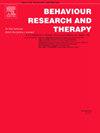Patterns of self-harm functions among clinic-referred youth: Associations with treatment outcomes
IF 4.5
2区 心理学
Q1 PSYCHOLOGY, CLINICAL
引用次数: 0
Abstract
Theories of self-harm (self-injurious behaviour that may or may not include suicidal intent) include behavioural components such as escape, coping, and reinforcement through emotion regulation. By better understanding the functions (i.e., reasons or anticipated consequences) of self-harm, we may be able to improve treatment outcomes. This is a secondary analysis of data from the Self-Harm Intervention: Family Therapy trial. We used latent class analysis to identify patterns of self-harm functions (e.g., interpersonal, intrapersonal) in adolescents who presented to services due to self-harm. Participants (N = 832, 11–17 years; 89 % female) completed a structured interview to provide information on the presence and functions of self-harm as well as a questionnaire on suicidal ideation. Five latent classes were identified: 1) self-harming to stop feelings of anger and communicate desperation to others (“Anger/Desperation”); 2) self-harming to relieve negative feelings, particularly anxiety, and to receive help (“Anxious/Distressed”); 3) both intrapersonal and interpersonal functions with a desire to receive help (“Mixed Inter-Intrapersonal; ”); 4) intrapersonal functions without an interest in seeking help (“Intrapersonal/Internalizing”); and 5) a low probability of intrapersonal and interpersonal functions (“Few Self-Harm Functions”). The Intrapersonal/Internalizing class had significantly higher suicidal ideation at 12-month post-treatment follow-up than the Few Self-Harm Functions class. Both the Anxious/Distressed and Intrapersonal/Internalizing classes were significantly more likely to have engaged in self-harm between baseline and 12-month post-treatment follow-up than the Few Self-Harm Functions class. The results highlight the need to identify effective treatment approaches to intervene on self-harm behaviour based on its functions.
自我伤害功能的模式在临床转诊的青年:与治疗结果的关系
自残理论(可能包括也可能不包括自杀意图的自残行为)包括逃避、应对和通过情绪调节进行强化等行为成分。通过更好地了解自残的功能(即原因或预期后果),我们可能能够改善治疗结果。这是对自我伤害干预:家庭治疗试验数据的二次分析。我们使用潜在类别分析来识别因自残而前往服务机构的青少年的自残功能模式(例如,人际、内省)。参与者(N = 832, 11-17岁,89%为女性)完成了一个结构化的访谈,以提供关于自残的存在和功能的信息,以及自杀意念的问卷。研究发现了五种潜在类型:1)自我伤害,以阻止愤怒的感觉,并向他人传达绝望(“愤怒/绝望”);2)自我伤害以缓解负面情绪,特别是焦虑,并获得帮助(“焦虑/苦恼”);3)同时具有个人和人际功能,并有接受帮助的愿望(“混合型人际间”);4)没有寻求帮助的兴趣的个人功能(“个人/内化”);5)内省和人际功能的概率较低(“很少有自我伤害功能”)。在治疗后12个月的随访中,内省/内化班的自杀意念明显高于少数自残功能班。在基线和治疗后12个月的随访期间,焦虑/痛苦组和内省/内化组都比少数自残功能组更有可能发生自残。结果强调需要根据自残行为的功能确定有效的治疗方法来干预自残行为。
本文章由计算机程序翻译,如有差异,请以英文原文为准。
求助全文
约1分钟内获得全文
求助全文
来源期刊

Behaviour Research and Therapy
PSYCHOLOGY, CLINICAL-
CiteScore
7.50
自引率
7.30%
发文量
148
期刊介绍:
The major focus of Behaviour Research and Therapy is an experimental psychopathology approach to understanding emotional and behavioral disorders and their prevention and treatment, using cognitive, behavioral, and psychophysiological (including neural) methods and models. This includes laboratory-based experimental studies with healthy, at risk and subclinical individuals that inform clinical application as well as studies with clinically severe samples. The following types of submissions are encouraged: theoretical reviews of mechanisms that contribute to psychopathology and that offer new treatment targets; tests of novel, mechanistically focused psychological interventions, especially ones that include theory-driven or experimentally-derived predictors, moderators and mediators; and innovations in dissemination and implementation of evidence-based practices into clinical practice in psychology and associated fields, especially those that target underlying mechanisms or focus on novel approaches to treatment delivery. In addition to traditional psychological disorders, the scope of the journal includes behavioural medicine (e.g., chronic pain). The journal will not consider manuscripts dealing primarily with measurement, psychometric analyses, and personality assessment.
 求助内容:
求助内容: 应助结果提醒方式:
应助结果提醒方式:


